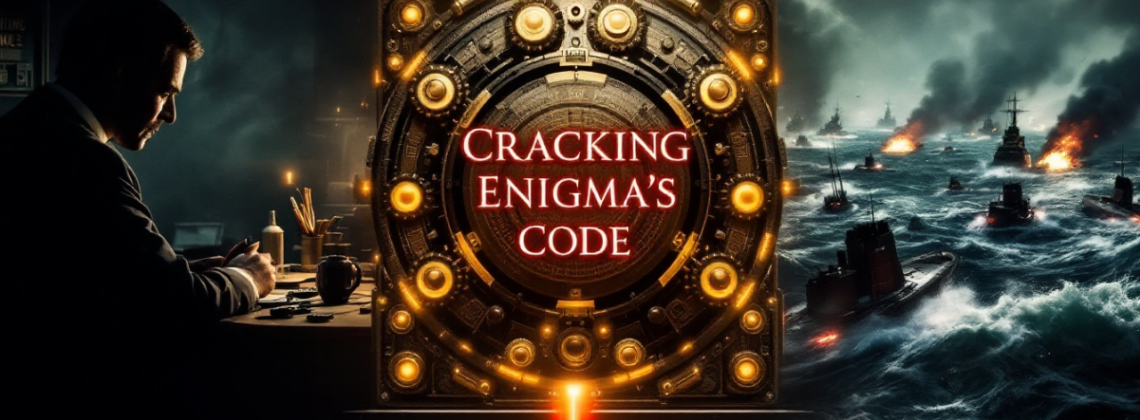
The Enigma machine stands as one of history’s most fascinating artifacts—a cipher device that symbolized German technological supremacy during World War II. However, what was once believed to be an unbreakable code became a pivotal turning point in the Allied victory. This is the story of how ingenuity, collaboration, and determination unraveled the secrets of Enigma, altering the trajectory of the war and leaving a legacy that continues to inspire.
What Was the Enigma Machine?
At first glance, the Enigma machine resembled a typewriter, but hidden beneath its unassuming exterior was a highly complex encryption system. The device used rotors, wiring, and plugboards to transform plain text messages into seemingly random strings of letters. With each key press, the rotors shifted, generating an ever-changing cipher that created an astronomical number of possible settings. This complexity made the Enigma code appear impenetrable, providing the German military with a false sense of invulnerability.
However, while the Germans placed immense confidence in the machine’s secrecy, cracks in their operational procedures and the brilliance of Allied minds would soon challenge that belief.
The Early Breakthroughs: How Polish Mathematicians Led the Way
Long before the war intensified, Polish mathematicians were already working to decipher Enigma’s secrets. In the 1930s, they identified weaknesses in German practices and applied sophisticated mathematical techniques to detect patterns in encrypted messages. Their groundbreaking efforts led to the development of early code-breaking devices, laying a critical foundation for future successes.
The contributions of these Polish pioneers were vital. As war loomed, they shared their findings with British intelligence, providing a head start for the Allied code-breaking efforts that would define the conflict.
Bletchley Park: The Heart of Code-Breaking Innovation
With the outbreak of WWII, Britain established Bletchley Park—a top-secret code-breaking center that became home to some of the brightest minds of the era. Mathematicians, linguists, chess champions, and other intellectuals worked tirelessly in this secluded estate to crack the Enigma code. Among them was Alan Turing, a mathematical genius whose contributions were nothing short of revolutionary.
Turing designed the Bombe, an electromechanical device that built upon the work of Polish mathematicians. The Bombe dramatically accelerated the decryption process by testing multiple rotor settings simultaneously. This innovation enabled the Allies to decode messages faster, providing timely intelligence that shaped military strategy.
The Power of Ultra Intelligence
The intelligence gathered from decrypted Enigma messages, codenamed Ultra, proved to be a game-changer. Ultra allowed Allied commanders to anticipate German movements, giving them a decisive edge in critical battles and campaigns. For example:
- In the Battle of the Atlantic, Ultra intelligence helped Allied forces outmaneuver German U-boats, securing vital supply lines.
- In Europe, decrypted messages provided strategic insights that influenced key military decisions, accelerating the push toward victory.
However, the Allies faced a constant challenge: maintaining the secrecy of their breakthrough. Any indication that the Enigma code had been cracked could prompt the Germans to change their encryption methods, nullifying the hard-won advantage. This secrecy required difficult decisions, including instances where commanders deliberately refrained from acting on Ultra intelligence to avoid suspicion.
The Legacy of the Enigma Machine
For decades after the war, the story of Enigma and the codebreakers at Bletchley Park remained classified. It wasn’t until the 1970s that the public began to understand the profound impact of their work. Today, the Enigma machine is a symbol of human ingenuity, perseverance, and the critical role of cryptography in modern warfare.
The combined efforts of Polish mathematicians, British codebreakers, and technological innovators like Alan Turing exemplify the power of collaboration in overcoming seemingly insurmountable challenges. Their achievements not only helped secure victory in WWII but also laid the groundwork for advancements in mathematics, computer science, and intelligence operations.
Conclusion
The story of the Enigma machine is a testament to the brilliance and determination of those who fought to protect freedom through intelligence and innovation. From the early breakthroughs of Polish mathematicians to the groundbreaking work at Bletchley Park, the decryption of Enigma reshaped the course of history.
What lessons can we draw from this incredible achievement? Perhaps it is the reminder that even in the darkest times, human ingenuity and collaboration can illuminate the path forward. What other untold stories of innovation from history inspire you? Share your thoughts and join the conversation.
